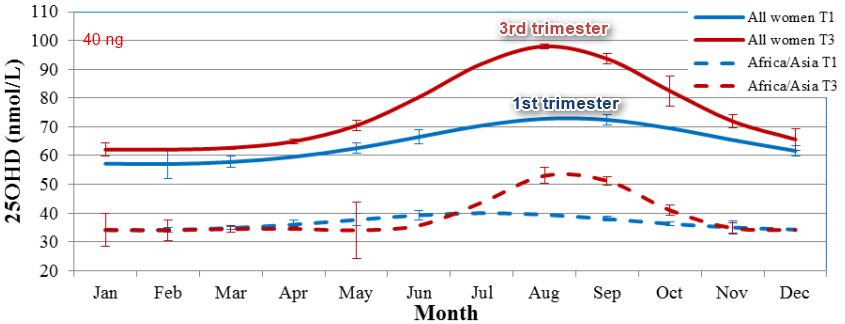Vitamin D levels rise during pregnancy
Vitamin D Status during Pregnancy in a Multi-Ethnic Population-Representative Swedish Cohort
Nutrients 2016, 8(10), 655; doi:10.3390/nu8100655
Linnea Bärebring 1, Inez Schoenmakers 2,3, Anna Glantz 4, Lena Hulthén 1, Åse Jagner 4, Joy Ellis 5, Mattias Bärebring 6, Maria Bullarbo 7,8 and Hanna Augustin 1
📄 Download the PDF from VitaminDWiki
Graphs of vitamin D during 1st and 3rd trimesters
Upper pair = All women (not just light skinned)
Lower pair = Asian/African women

If very low Vitamin D (< 12 ng) the woman is 22X more likely to be an Asian woman

Specuation: Muslim women wearing concealing clothing, and Swedish women taking cod liver oil and/or fish diet
There is currently little information on changes in vitamin D status during pregnancy and its predictors. The aim was to study the determinants of change in vitamin D status during pregnancy and of vitamin D deficiency (<30 nmol/L) in early pregnancy. Blood was drawn in the first (T1) and third trimester (T3). Serum 25-hydroxyvitamin D (25(OH)D) (N = 1985) was analysed by liquid chromatography tandem-mass spectrometry. Season-corrected 25(OH)D was calculated by fitting cosine functions to the data. Mean (standard deviation) 25(OH)D was 64.5(24.5) nmol/L at T1 and 74.6(34.4) at T3. Mean age was 31.3(4.9) years, mean body mass index (BMI) was 24.5(4.2) kg/m2 and 74% of the women were born in Sweden. Vitamin D deficiency was common among women born in Africa (51%) and Asia (46%) and prevalent in 10% of the whole cohort. Determinants of vitamin D deficiency at T1 were of non-North European origin, and had less sun exposure, lower vitamin D intake and lower age. Season-corrected 25(OH)D increased by 11(23) nmol/L from T1 to T3. The determinants of season-corrected change in 25(OH)D were origin, sun-seeking behaviour, clothing style, dietary vitamin D intake, vitamin D supplementation and recent travel <35° N. In conclusion, season-corrected 25(OH)D concentration increased during pregnancy and depended partly on lifestyle factors. The overall prevalence of vitamin D deficiency was low but common among women born in Africa and Asia. Among them, the determinants of both vitamin D deficiency and change in season-corrected vitamin D status were fewer, indicating a smaller effect of sun exposure.
